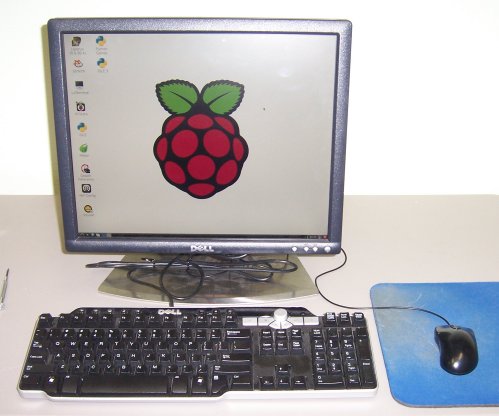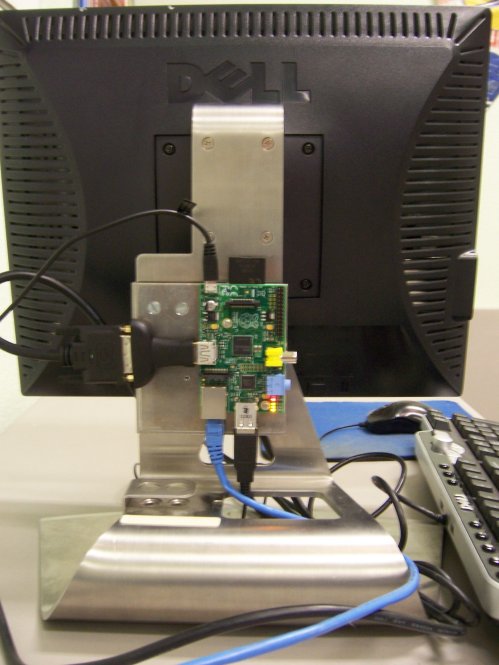I wonder how many Raspberry Pi boards will spend their entire working lives sitting cockeyed on a desk somewhere, at the center of a tangle of cables. That’s how mine was until a couple of days ago, when despite my cough I allowed myself a few minutes of quality screwdriver time to pull a proper RPi system together.
It didn’t take much. Mostly what it took was a 2004-era Dell SX270 all-in-one system minus the SX270, which I now use as a bookend. The key component is a heavy stainless steel base with a VESA monitor mount and a bracket to hold the SX270 behind the monitor. The monitor itself is an unexceptional Dell 1704fp, with a native resolution of 1280 X 1024. (Those now sell for ~$50 on eBay.) That’s more than enough pixels for an RPi, although I tested it on one of my 21″ 1600 X 1200 behemoths and the little gadget did quite well overall.

I had already mounted the board on an aluminum plate, and all I had to do this time was drill two holes and bolt the plate to the SX270 mounting bracket. I may dress the wires a little to keep them from placing any torque on the connectors, but it works well as-is.
I was surprised to find out that the MagPi magazine is actually laid out on an RPi, using the open-source Scribus layout program. I installed Scribus via apt-get and poured some text into a layout. (I’ve been playing with Scribus for years.) Brisk! I guess we need to stop boggling at the capabilities of tiny little computers with all of two ICs on the mobo.
It certainly does a good job with FreePascal and Lazarus, which is why I went to all this trouble. They’ve now sold half a million of these things. At least a few of those people ought to be willing to buy a Lazarus tutorial for it. We’ll see.











Based on their blog post, I suspect the number of Pis sold is closer to one million – one of their two distributors reported selling over 500k, and if Allied has done similarly well, they’re probably past the 1M mark already. (I’m still anxiously waiting for my Pi to arrive. I just hope I don’t get one of the Chinese-made models, which seem to have a higher failure rate.)
On the one hand, the RasbPi is a really neat technological marvel. It’s incredible that they can pack the equivalent of a whole PC into such a small inexpensive package.
On the other hand, I wonder what they will actually get *used* for. How many people will use one to replace their PC, or use it for some other serious purpose? How many of them will just be toys, or sit in a drawer somewhere?
I’m reminded of a Broom Hilda cartoon at Tullio Proni’s house. Gaylord is working in his shop. Broom Hilda asks, “What’s that?” Gaylord says, “It’s my milling machine.” “What do you make with it?” she asks. “Parts for my milling machine,” he replies.
The RasbPi seems like a wonderful tool. But what is it a tool FOR? What does it do that you can’t already do, with computers you’ve already got?
Well, as I understand it the intended primary purpose of the Raspberry Pi is to be an ultra-low-cost educational computer. In my opinion the concept is vaguely reminiscent of the One Laptop Per Child project (http://en.wikipedia.org/wiki/One_Laptop_per_Child) As such, if you are not in the low-budget computer science education business then you are not it the target audience.
However, architecturally the Raspberry Pi seems to me to be somewhat similar to a home / small office router, or more generally a ‘plug computer’ (http://en.wikipedia.org/wiki/Plug_computer) Perhaps the Raspberry Pi could be used as a low power web server? At 3.5 W leaving it on 24/7 won’t put a very big dent in your electric bill, which isn’t so much the case with the computer you already have (even if it is a laptop it’s probably using at least 50 W, and desktops can often use a few hundred watts). But, strictly speaking, in regard to “What does it do that you can’t already do, with computers you’ve already got?” — assuming you have a modern desktop or laptop I think the answer to that is nothing. I could be wrong, as I am wrong quite regularly.
I think the target markets are education and hobbyists, not the general public. Since mine has yet to arrive, I could just be dreaming or talking through my hat, but I think the main appeal of the RPi is its size for its completeness. You effectively get a full-blown PC with USB, video, networking, and interfaceability (I guess I need to add that last one to the Urban Dictionary) that’s the size of a credit card and can run from AA batteries. Applications I’m thinking about include robotics (somewhat obvious) and adding intelligence and connectivity to otherwise-dumb devices (such as my car or my garage door opener). Someone a bit more devious might create an all-in-one WiFi sniffer with automatic WEP cracking, which could be carried unobtrusively in one’s pocket to collect all sorts of data from public sites, or even mailed cross-country to oneself or one’s accomplice, illicitly gathering data every step of the way (at least as long as the batteries hold out). I’ve long been interested in home automation, and the RPi’s size and price point could allow a whole lot of distributed intelligence and control for a meager investment. The RPi site contains links to many creative projects folks have come up with, including micro routers, media players, camera interfaces, VoIP devices, and someone even sent one with a webcam 25 miles up (and back) using a hydrogen balloon. I’m thinking that one of my old TVs could be retrofitted to become a streaming device, extending its life for a few more years. It’s like having an embedded environment, but with few constraints. The possibilities seem endless – anything where size and/or portability are essential.
True, I could bolt a laptop to the back of my old TV, or strap one underneath the driver’s seat of my car, or hang one on the wall near my sprinkler controls, but I think using a Raspberry Pi is a far more elegant solution. Far cheaper, too.
I’ve thought long and hard about the future of extremely small, inexpensive (~$0), open platform, open source devices, but it’s going to take a younger mind than mine to figure this out. There seem to be two major platforms in this category now, the Pi and the MK 802 series of computers. Perhaps the Google glass and other wearable devices will finally come of age. This is a fascinating question.